Why companies are converting their forklift fleets to electric


Why companies are converting their forklift fleets to electric
As a supplier of both internal combustion and electric powered lifting equipment, we often receive questions about which powered lift equipment is the best to utilize in various applications. For the last 30 years, battery-powered electric equipment has been steadily replacing internal combustion power as the preferred choice for industrial forklift fleets. Battery-powered forklifts positively impact every aspect of a business by improving on several factors: savings, sustainability, safety, productivity and performance.
Savings can be measured by reducing total cost of ownership over the life of the forklift. In a recent study by the Electric Power Research Institute, it was found that $.040 worth of electricity does the same work as $2.50 worth of liquid propane. In addition, electric forklifts have fewer moving parts which can reduce maintenance costs up to 40%. When applied to a fleet with multiple forklifts, the fuel savings alone can be substantial. On a single L.P. type machine running 2,000 hours per year with a burn rate of 1.5 gallons an hour and a cost of $2.50 per gallon, it would use about $7,500.00 per year in fuel. Comparatively, an electric forklift running 2,000 hours a year, burning 6KW/hr and 1KW costing $0.10 the fuel cost would be $1,200.00 per year. That’s a savings of $6,300.00 a year in fuel alone.
Electric power produces the lowest well-to-wheels greenhouse gases of any fuel source. Compared to fuel cells or liquid propane, battery power is better for attaining sustainability goals; and it is better for the environment. Electric forklifts, in turn, eliminate on-site carbon dioxide, carbon monoxide and nitrous oxide, which are all byproducts of burning fossil fuels. Safety is also a major consideration because electric machines eliminate oil and coolant spills therefore reducing accidents and injuries. The typical lead acid battery in an electric machine is also 98% recyclable.
Productivity can also be improved, as there is no longer the need to change fuel tanks or fill an onboard tank. In existing electric fleet application with multiple shifts (where changing batteries used to be necessary), there has been a steady increase in high-frequency fast charging that allows the customer to run an electric machine multiple shifts with a single battery.
Performance of new electric lift trucks has also come a long way in recent years. They were once regarded as lower-performing than internal combustion forklifts, but today they are at the same lever. DC powered electric machines have, for the most part, all been replaced with more energy-efficient AC technology. This has enabled manufacturers to build machines with higher efficiency sealed electric motors. The older DC machines were limited by exposure to dirt, water, etc. that limited their operation to indoor applications with smooth concrete floors. With the addition of AC technology and sealed motors, there are now electric lifts with capacities up to 100,000 pounds that can be regularly utilized in an outside environment.
Today, it is not uncommon to see electrics working outside in paper, lumber or building supply operations where you would typically find an L.P. or diesel forklift. There is also an increasing number showing up in manufacturing, beverage and bottling, agriculture, processing, and in third-party logistics and distribution companies. No matter what the industrial application, it is safe to say there is an electric forklift that can get the job done.
(This sponsored content was provided by FMH Material Handling Solutions.)
Sources: EPRI, Industrial Truck Assocation, and the GREET model Fleet Footprint Calculator.













